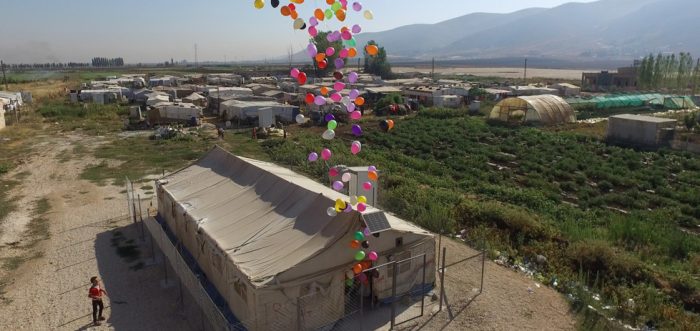
Lebanon has received over 1,000,000 registered refugees since the Syrian Civil War began in 2011, and estimates of unregistered refugees are as much as double that number. Taking only the midpoint of these two figures, refugees currently account for a quarter of Lebanon’s total population. Despite this, there aren’t any formal Syrian refugee camps within Lebanon, though a great many reside in the Bekaa Valley.1 The valley extends 120km in length and 16km wide, with refugee camps spread across the region. This pattern of distribution leads to relatively smaller communities than those in more encompassing, established zones like Jordan’s Zaatari camp. Camp Khiara – one of the many camps within Bekaa Valley – is an obvious location for Dutch filmmaker Leonard Retel Helmrich, whose career is marked by a candid, close-up and intimate approach to documentary, to centre a work on the Syrian refugee crisis.
Helmrich’s films adhere to the central concept of ‘Single Shot Cinema’, which was inspired by Andre Bazin’s view that a moving camera is the essence of filmmaking: “it should not cut up reality, but rather it should show reality in its temporal continuity” and it must anticipate remaining still as much as it should be prepared to move. Helmrich has a sense for this improvisational and innovative approach; films like Eye of the Day and Shape of the Moon cemented his reputation as one of the more adaptable and malleable lensmen in the field. For The Long Season, though, he has handed the camera to Ramia Suleiman: an expat from Syria who had never made a film before. The Long Season sees Suleiman take on Helmrich’s guiding tenets: the method prioritises long takes, with framing and camera movement orbiting the subject. The goal is a candid familiarity and emotional access, which handing the camera to Suleiman achieves. Suleiman’s involvement moved beyond beyond her camerawork for the film when Helmrich suffered a heart attack in 2017, which left him in a coma. At this point the production team decided to offer Suleiman the reigns to finish the film. After watching the edit, Helmrich gave a frank statement of approval: “this is very good expression of single-shot cinema.”
As the camera meanders through Camp Khiara with fluidity, Helmrich introduces the community through sequences of everyday mundanity. At first, the film’s intentions aren’t entirely clear as we watch Abu Hussein – an older man with two wives, who informs the camera he could have had four – in the middle of an argument between his pregnant first wife Yisra and his second wife Zahra. There’s haste missing from the tension here, implying an acceptance of sorts: whatever the dispute is, it doesn’t need a resolution anytime soon, as nothing is changing. Groceries are bought from a store run out of a ute, children take classes at a makeshift school, and families work to maintain their temporary housing situations while they wait to hear word from back home. For most in Camp Khiara, this means Raqqa, occupied by Islamic State at the time of filming.
Muted desperation frames conversations about the conflict. In one interaction, the ever-repeated question of “how is it in Raqqa?” is met with the euphemistic “not so good”. The second recurring query “is it okay with ISIS?” receives a blunter reply: “no.” These conversations exist as brackets in a narrative more concerned with capturing the everyday lives of those who wait. Helmrich described the characters in his film as having “futures postponed by war”. In The Long Season we’re introduced to these characters at this point, in a state of suspension, of waiting. It’s a change of focus for documentaries centred on the the Syrian conflict and its fallout. Helmrich’s film knows what it wants to explore, maintaining its focus on it throughout. It’s not an impassioned call to arms, side-stepping the feature of some sort of call for intervention that was often coupled with documentaries released in earlier years of the conflict.
Unlike many festival documentaries on the conflict, Helmrich’s work doesn’t aim to delve into the causes, its current state, or offer up solutions. As in all his films, the primary interest is in human intimacy – and in The Long Season, that focus is drawn to the intricacies of how the conflict echoes on the small scale: striving to capture the stark and painful limbo in which the people in this camp exist. It finds emotional peaks in domestic scenes depicting the economic strife of the situation: a family having their electricity unexpectedly cut after failing to meet a payment is one of the most emotionally resonant moments in The Long Season. In a camp full of makeshift houses and UNHCR tarpaulins, electricity is still precariously accessible. And despite the ever presence of NGOs, the UNHCR tarp does little more than flap helplessly in the wind as a man – Camp Khiara’s closest equivalent of a landlord – climbs down from the electricity pole, and the reality of the situation begins to set in.
